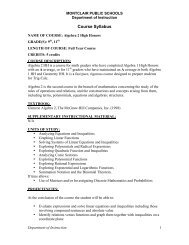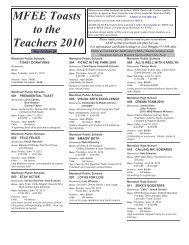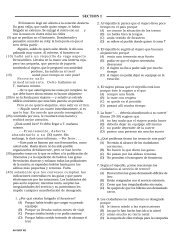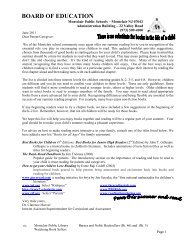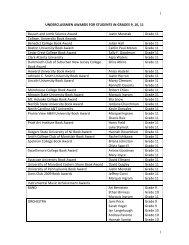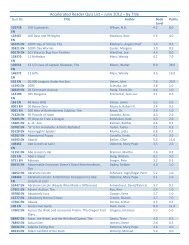Montclair Public Schools CCSS Algebra 2 Honors Unit 3: Marshall ...
Montclair Public Schools CCSS Algebra 2 Honors Unit 3: Marshall ...
Montclair Public Schools CCSS Algebra 2 Honors Unit 3: Marshall ...
You also want an ePaper? Increase the reach of your titles
YUMPU automatically turns print PDFs into web optimized ePapers that Google loves.
F.BF.1<br />
interest rate if the annual rate is 15%.<br />
Write a function that describes a relationship<br />
between two quantities. Combine standard<br />
function types using arithmetic operations. For<br />
example, build a function that models the<br />
temperature of a cooling body by adding a<br />
constant function to a decaying exponential,<br />
and relate these functions to the model.<br />
7<br />
8<br />
courses) as well as compounding interest models<br />
(relating to finance and economics courses).<br />
Compare exponential and linear growth rates and<br />
determine during which intervals exponential growth<br />
may be slower than that of linear growth.<br />
Construct a function that combines standard function<br />
types using arithmetic operations to model a<br />
relationship between two quantities.<br />
3<br />
4<br />
F.LE.4<br />
For exponential models, express as a logarithm<br />
the solution to ab^c = d, where a, c, and d are<br />
numbers and the base b is 2, 10, or e, evaluate<br />
the logarithm using technology.<br />
9<br />
SC 10<br />
Students will construct functional models of real-world<br />
situations.<br />
Identify the inverse relationship that exists between<br />
logarithms and exponential functions. Students<br />
should apply this to problem solving involving<br />
exponential and logarithmic functions.<br />
3<br />
3<br />
11<br />
Express as a logarithm, the solution to ab^c = d, where<br />
a, c, and d are numbers and the base is 2, 10 , or e.<br />
3<br />
12<br />
Evaluate the logarithm using either graphing or<br />
scientific technology.<br />
3<br />
13<br />
Apply laws of logarithms to either expand or contract<br />
a given logarithmic expression.<br />
4<br />
F.IF.7e<br />
Graph exponential and logarithmic functions<br />
showing intercepts, and end behavior, and<br />
trigonometric functions, showing period,<br />
midline, and amplitude.<br />
SC 14<br />
Graph functions expressed symbolically and show key<br />
features of the graph (including intercepts, intervals<br />
where the function is increasing, decreasing, positive<br />
or negative; relative maxima and minima; symmetries,<br />
and end behavior) by hand in simple cases and using<br />
technology in more complicated cases.<br />
(Students encouraged to use graphing technologies)<br />
2<br />
15<br />
Interpret the parameters in an exponential function in<br />
2<br />
2013-2014



